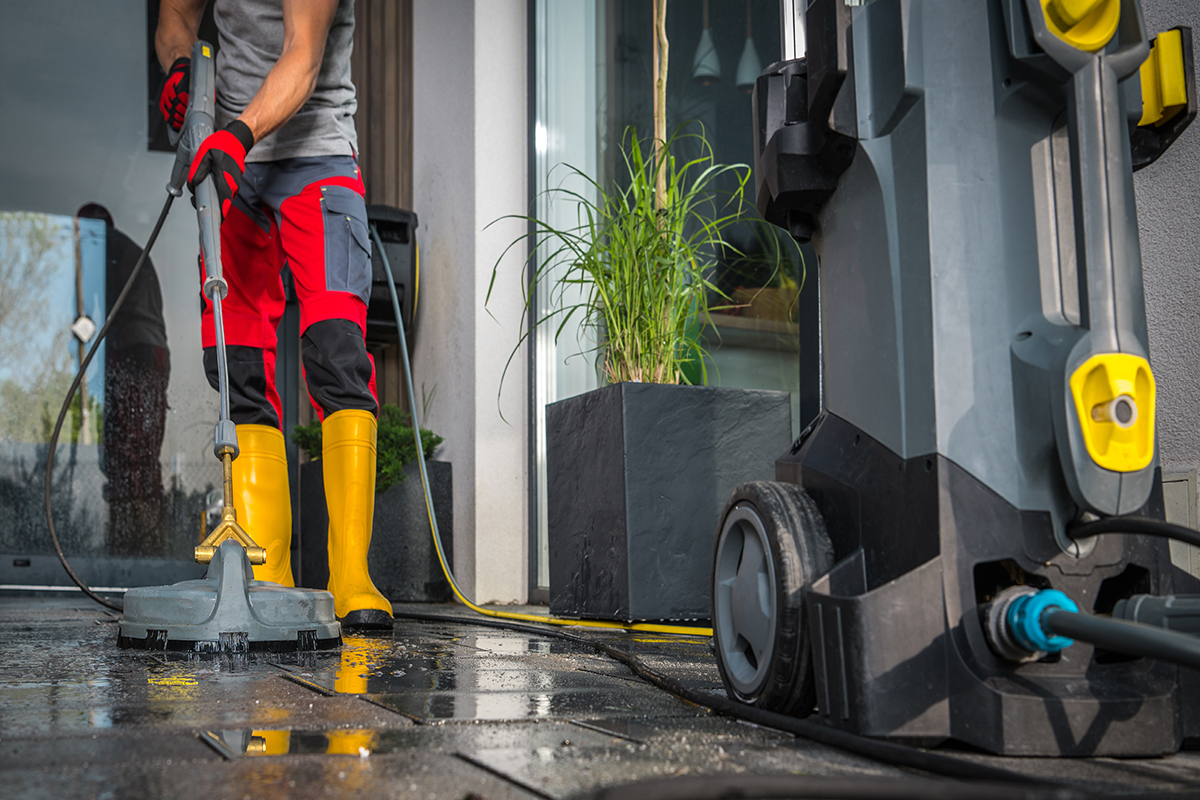A home inspection is a procedure or examination to identify defects and establish the condition of different parts of the house before finalizing the purchasing process.
A home inspection checklist is a complete list of the conditions or defects in a house that have to be verified. The areas are ticked or crossed off the checklist as their condition is validated during the inspection.
Inspection is part of due diligence before buying a house. This is because an inspection guarantees that you do not buy a home that has faults. An inspection is meant to uncover pre-existing defects in the different parts of the house. You will typically hire a home inspector to carry out the inspection and prepare a report that outlines the condition of different home components and areas where maintenance is needed to comply with housing standards.
The checklist ensures that you do not miss any defects that are likely to be found within the house. If any defects are identified, you have the option to renegotiate the deal or forego the purchase completely. This is because house defects affect the value of a house as they can pose a safety and financial risk to you as the buyer. However, for this to be duly possible, an inspection contingency is added to the home purchase contract. This provision allows the buyer to inspect the house and gives them legal leeway to proceed as they see fit after inspection.
Some areas included in an inspection checklist include HVAC systems, foundation, electrical and plumbing systems, drywall, roof, sewer system, etc. Defects in these areas have high-cost implications if not addressed before buying the house. A checklist is thus your safety net before closing. This article gives more details on what a checklist is, its components, and how it can be used to get its maximum benefit.
What are the Benefits of Home Inspection?
Buying a home is an expensive investment. So, as a buyer, you should aim to mitigate any additional costs. That is why it is imperative to carry out an inspection. The benefits of home inspection cannot be overstated. An inspection confirms the current condition of the house, thus assuring you that buying the house is a good investment.
Carrying out an inspection offers the buyer an extra layer of protection from after-purchase repairs. It is difficult to judge the condition of a house based on face value or appearance. It is easy for a house to have good finishing and defects within. An inspection guarantees that any barely visible issues are identified and fixed before closing.
A home inspection prepares you for any repairs you may need after buying a house. This way, you can budget and avoid the stress and inconvenience of making impromptu repairs.
The current and future condition of a house affects its market value. So, verifying the current condition of the house allows you to negotiate for a fair price and protects you from paying more than the house is worth. You can negotiate for a discount or request the seller to do the repairs before closing.
How Home Inspection Works
Defects that go undetected by the buyer after buying a house can cause expensive repairs or even cause injury to family members. So, a poorly conducted inspection can pose high financial and safety risks. Therefore, following the right procedure for a home inspection is imperative. While it may seem time-consuming and strenuous, a proper professional inspection is invaluable.
Below are the steps a buyer can follow to get a successful inspection by a licensed home inspector:
Step 1: Include a home inspection contingency clause
Due to the financial and legal implications of home purchases, some formality must be in place for a home inspection to be a viable reason for renegotiating or walking away from a home purchase contract. A home inspection contingency clause is included in the contract for this purpose. It clarifies that you, the buyer, will buy the house contingent on the results obtained after a home inspection. This provision typically has a limited validity timeframe of one or two weeks.
The house inspector and other specialists are expected to conduct their assessments and provide a report by the end of this validity date. If any follow-ups are to be done to verify the inspection results further, they should be done within this allotted time frame. Once the inspection is completed, the clause awards you the right to terminate or renegotiate the contractual terms of purchase.
Step 2: Find a home inspector
There are different ways of finding a credible home inspector. A credible inspector has met the state’s requirements of a practicing home inspector. The ASHI (the American Society of Home Inspectors) provides a platform that outlines the requirements of authorized home inspectors in each state.
However, these requirements will vary from state to state. For example, home inspectors in Georgia do not have to be licensed, while in Texas, Nevada, and Arizona, home inspectors must undergo training and pass examinations to be licensed to operate in those states.
- You can find an inspector by asking for suggestions from your real estate agent, family, friends, colleagues, or future neighbors. Once you have identified suitable inspectors, you can vet them further in several ways.
- Ask them for references/ clients they have served. Contact them and enquire about the nature of their services.
- You can also request a sample report on a house they have previously inspected. Evaluate the report to determine what the inspector includes in their reports and how thorough they are. Note that long reports do not necessarily imply quality inspections.
- Ask nearby homeowners for recommendations. Verify the legitimacy of the inspector by confirming if the inspector’s office is licensed, bonded, and insured. This increases their credibility and your trust in them.
- Read online reviews of the candidates.
- Conduct an interview and ask questions of your own that reflect the type of service you are looking for. Your questions can revolve around the number of homes they have inspected, their specialty – residential or commercial real estate, what a typical inspection entails, if you can be present during the inspection and ask for sample reports.
Remember, the home inspection is bound by the time limit imposed by the house inspection contingency provision. So, these steps should be taken in good time to avoid delays. This is especially if further examinations have to be carried out should the inspector identify issues in the house.
You can find an inspector in the early stages of home buying so that an inspection can be done as soon as your offer is accepted. Inspectors can be in high demand, especially during peak seasons in the market. Expect to acquire a home inspector’s services for around $350-$600 ($450 on average). The price is affected by the size and location of the house. However, be sure to budget for additional investigations by specialists.
Also, if additional time is needed for the additional examinations, be sure to discuss it with the seller, as it is their decision whether to extend the timeframe or not.
Step 3: Get a seller’s disclosure statement
Next, you should get a disclosure statement from the seller. A disclosure is a document meant to disclose any information you need to be aware of before committing to buy the house. The seller is expected to be truthful in this document and be forthcoming to avoid misleading you into buying an unsatisfactory home.
Ideally, you should request the disclosure before the inspection. This is so that the inspector can be aware of areas where renovations or repairs have already been done. Typically, it is written in a yes or no question format. In some cases, a disclosure is a state requirement. The state determines what information is included in the document.
Step 4: Identify your deal breakers
Repairs can be costly, especially on major parts of the house, such as plumbing, structural work, or electrical systems. You should therefore have a budget for the amount of money you are willing to spend on repairs. You should reference this limit as the inspector identifies defects. If the issues identified would cost more than you are willing to spend on repairs, you can then decide if you want to buy or forgo the house.
Step 5: Read your home inspection report carefully
Once the inspection is completed, go through the final report thoroughly. The major issues will be noted at the beginning, followed by detailed explanations. Pictures are also included to show the noted defects. You should consult the inspector on issues that need further clarification. If the list of issues is long, you might want to reconsider buying the house.
Note that the inspector does not appraise the cost of repairs or the useful life of systems and appliances in the house. So, you might want to consider consulting local home improvement contractors to estimate the cost of repairs before making a final decision. Some defects you should be wary of are cracks in the foundation, poor ventilation and drainage, pest infestation, and mold.
Step 6: Negotiate repairs after the home inspection
After identifying the needed repairs, you can approach the seller to negotiate how the financial obligations will be met. For example, you can negotiate to have the seller handle the major repairs while you pay for the minor repairs. Major issues include flooring defects, roofing issues, HVAC, etc., while minor issues are basically normal wear and tear. Alternatively, the seller can ask to lower the price of the house and absolve themselves of any obligations towards repairs.
In some cases, contingencies can be added in the contract where the seller will take up any future obligations should an issue arise due to issues identified during the home inspection. Note that some sellers will decline any purchase contracts with contingencies where you are expected to buy the house without undertaking any inspection.
Step 7: Follow up
After repairs are done on the house, you should verify that they were performed as per the contract. It is a good practice to get the same professional inspector or specialist to go through the house and verify if all the defects have been adequately fixed and up to the needed standards.
What to Include in a Home Inspection Checklist
Before the home inspector starts inspecting and making their inspection report, consider preparing your own checklist. You can customize it to include other specific areas you want to be inspected. This way, you can ensure they properly inspect your areas of concern.
Standard checklists have been provided by ASHI and NACHI (International Association of Certified Home Inspectors) for certified home inspectors to use.
The areas addressed by these checklists include the following:
Foundation
The foundation should be inspected for cracks, leveling, drainage, etc. In addition, the inspector should make sure that the slab has not been affected by other things in its surroundings, such as pipes or nearby trees.
Structure
The structure represents the major parts that make up the house. These include walls, floors, ceilings, beams, support posts, chimneys, etc. Inspections should check for cracks, leaks, and/or wear, sagging, termites, etc. Also, check for paint condition.
Exterior
The exterior of your potential home comprises the septic tank, gutters, drainage pipes, roof, etc. The exterior parts are subject to harsh elements such as the sun, rain, and wind. Therefore, they should be included in the checklist as they can affect the quality of life you will have in your new home and its value. The inspector should check for leaks in the septic tank, stagnant water, roof decay, clogged gutters, rusting parts, etc. In addition, inspect windows for damage, such as cracks in frames or caulking.
Interior
Inspect the living quarters, such as the rooms and kitchen, for defects, poor condition, or wear in appliances, fixtures, and fittings. Check for mold in the attic or other places. Also, check for proper insulation, electrical outlets, window frames, smoke detectors, stains on the walls and floors, leaking sinks, etc.
Plumbing and electrical
Plumbing and electrical systems should be inspected for defects and poor condition. For example, there might be possible issues with pipes, such as leaks in the water pipes, rusty pipes, functional water pumps, leaking gas pipes, or clogging in the drain. The same applies to electrical systems such as exposed wires, faulty outlets, overhanging cables, burnt-out fuses, and locating the service panel.
HVAC
The house should have HVAC systems. They should be checked for proper airflow and if the fans and vents are functional. The home inspection list should enlist the presence of rust in the cooling unit, functional air filters, and if each room receives sufficient airflow. Also, inspect for broken or loose parts on the AC unit, if the heated water temperature exceeds 125 degrees Fahrenheit and if there is a history of asbestos in the air ducts.
Kitchen
The kitchen should be inspected for functional appliances and wear and tear in fixtures, cabinets, and flooring. Also, verify if there is an exhaust fan, proper drainage, if the outlets are properly covered and far from sinks, and if there is mold in cabinets, joints, and cracks.
Bathrooms
The bathrooms should also be included in the home renovation checklist. Some of the things to inspect in this section include proper drainage, rust in pipes, sufficient water flow with adequate pressure, a functional toilet, leakages, and proper caulking.
Other Considerations
You can include other items in the checklist to further protect yourself from costly repairs and maintenance after buying the house.
Such items include:
EIFS
EIFS (Exterior insulation and finish systems) are exterior building materials that are stucco or synthetic coating applied to the exterior of homes. There have been reports of issues with EIFS, such as rot, stained walls, sagging material, mold, etc., especially if improperly installed. A drainage plane should be added to drain water if the EIFS is applied directly to the substrate with mastic or fasteners. Inspections should detect the presence of EIFS and check all its components to ensure they are properly installed and durable.
Lead-based paint
Lead can have adverse health effects on the homeowner and the occupants. Lead-based paint is a common source of lead poisoning, and this should thus be included in the checklist. This examination is more so for houses built before 1978. Inspections should check for chipping, smeared paint, peeling, cracking, and peeling or missing coverings in all areas that could expose children to it.
Mold
Mold can be a serious health hazard as it can cause respiratory and other issues. Mold inspections are conducted through questionnaires, visual inspection, and mold testing. Mold testing costs between $300 and $3000, depending on the number of samples and house size. Inspections should check for visible mold, debris, and wet areas that could harbor mold and all components that retain moisture.
Radon
Radon is a harmful gas emitted from the ground into the air. Radon can cause lung cancer, respiratory and neurological problems, and others. Therefore, radon testing should be included in the checklist. The radon levels should be within the ERA recommendations. If not, be prepared to mitigate it if it is 4 picocuries per liter (pCi/L) and above.
Roof certification
The roof must be inspected to ensure leaks have been identified and if there is a risk of potential collapse. You should plan on hiring a roofing company to do the inspection. The inspection is done to verify the condition of the materials, the functionality of the drains and gutters, and how rigid the roof has been fixed. The roofing contractor should also inform you of the estimated life of the existing roof in years before it has to be replaced.
Sewer
The sewer should be inspected to make sure that it is functioning properly and has not been clogged or damaged. This is critically important for houses that are older than 20 years. Hire a plumbing company to get a thorough examination. You can get these services for $85-$3000.
Termites
The house should be inspected for evidence of wood-destroying insects such as termites, ants, or beetles. These insects can cause structural damage to your home and reduce its value. In some cases, this inspection is often mandatory if you are financing the house using an FHA (Federal Housing Agency) or VA (Veterans Affairs) loan or ordinary mortgage. In addition, inspections should check for holes and damaged wood in the house’s interior and exterior.
Free Templates
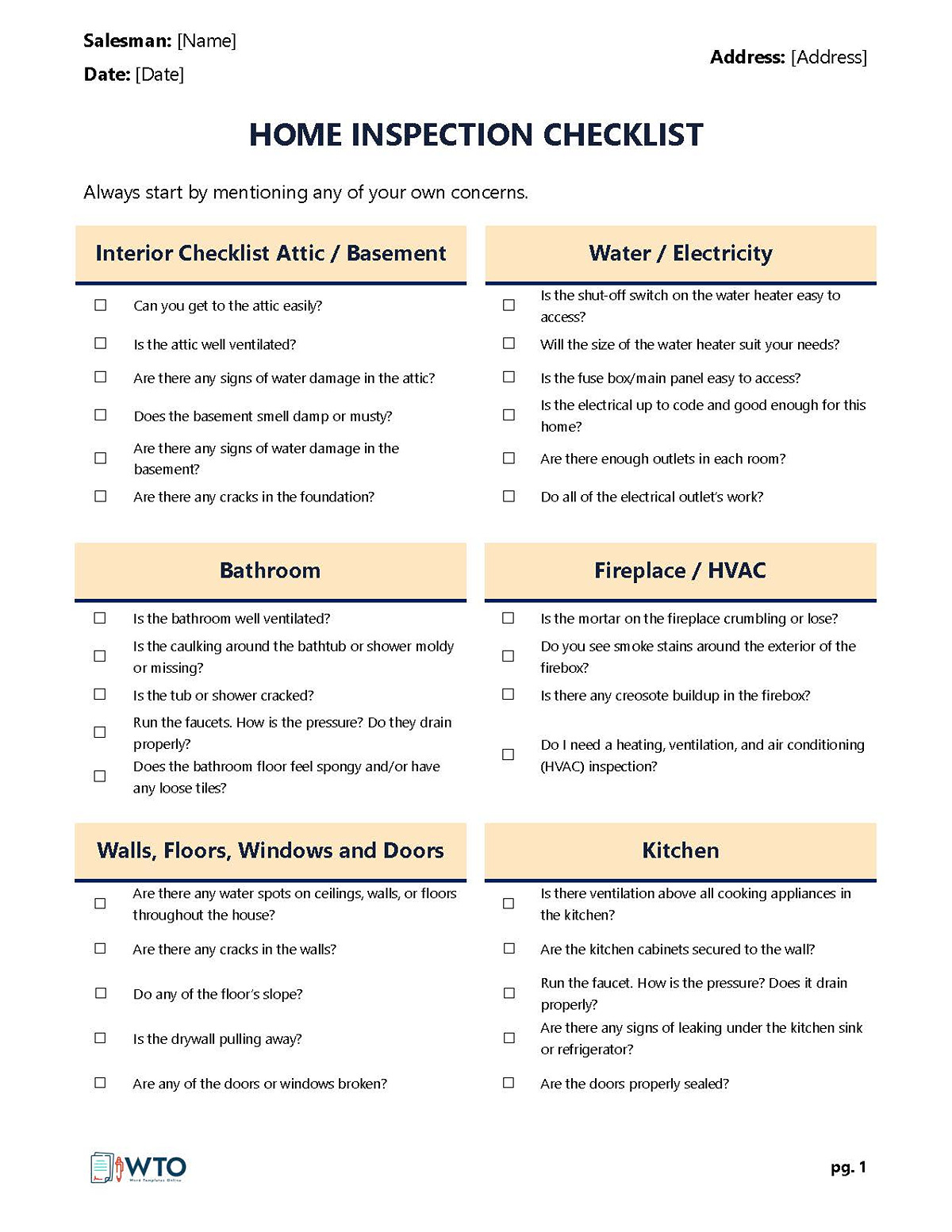
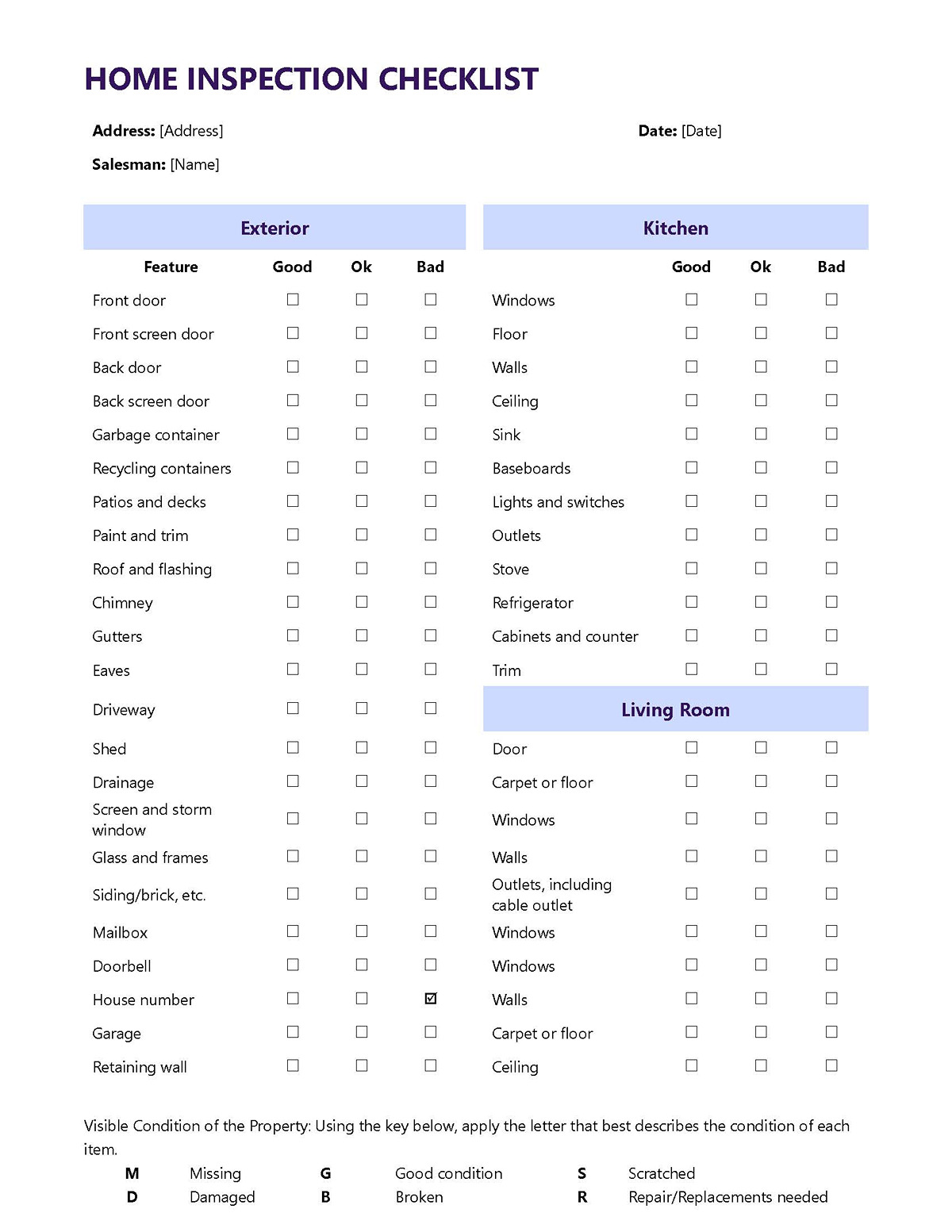
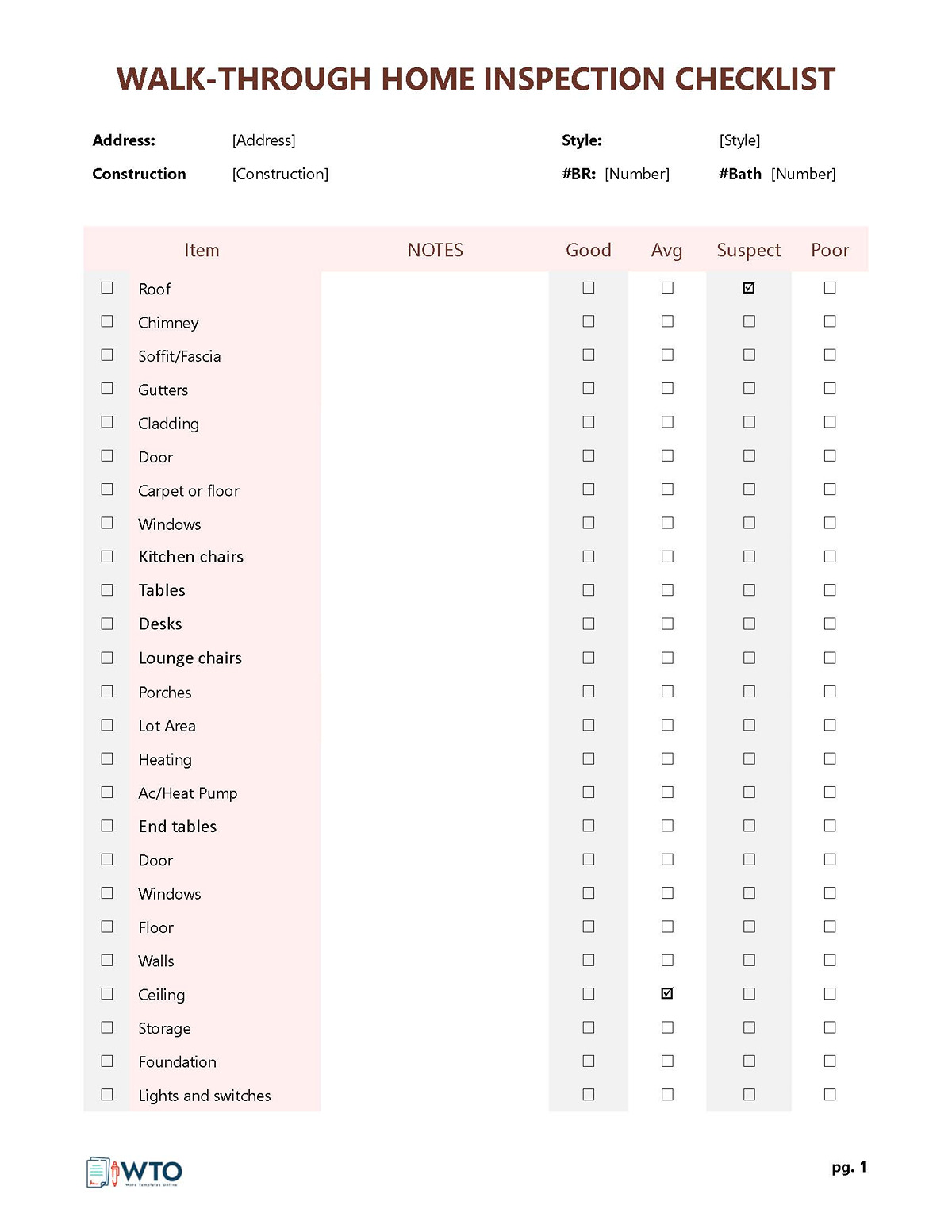
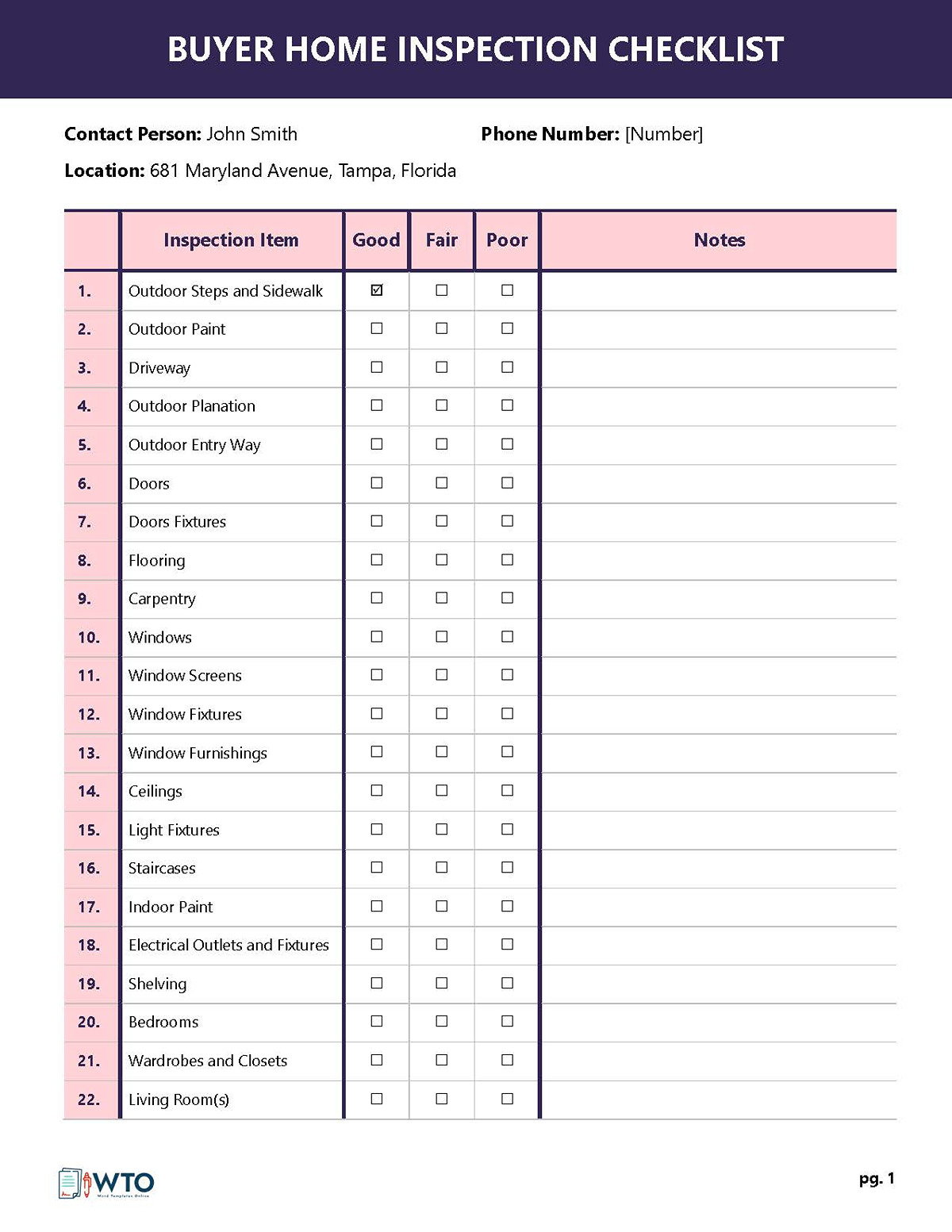
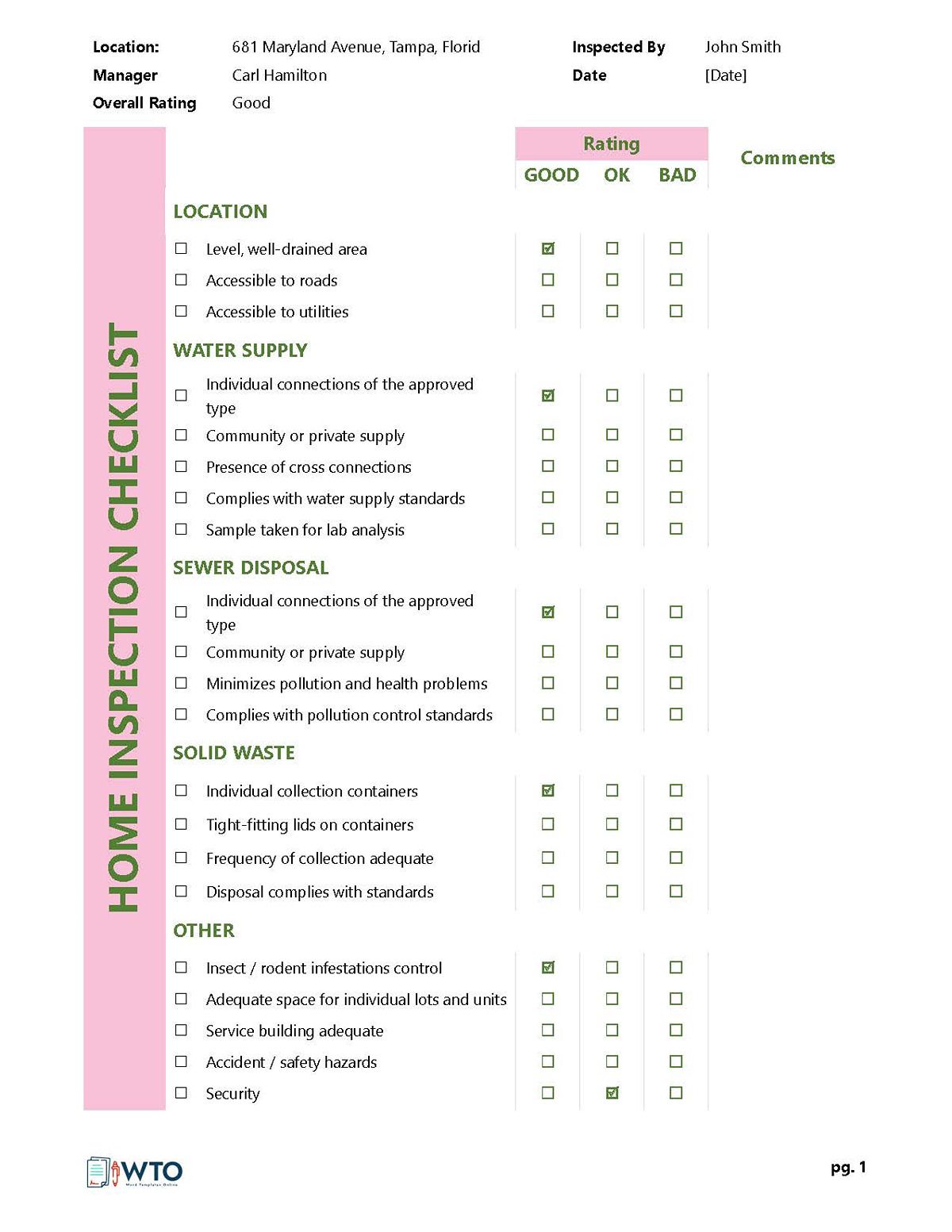
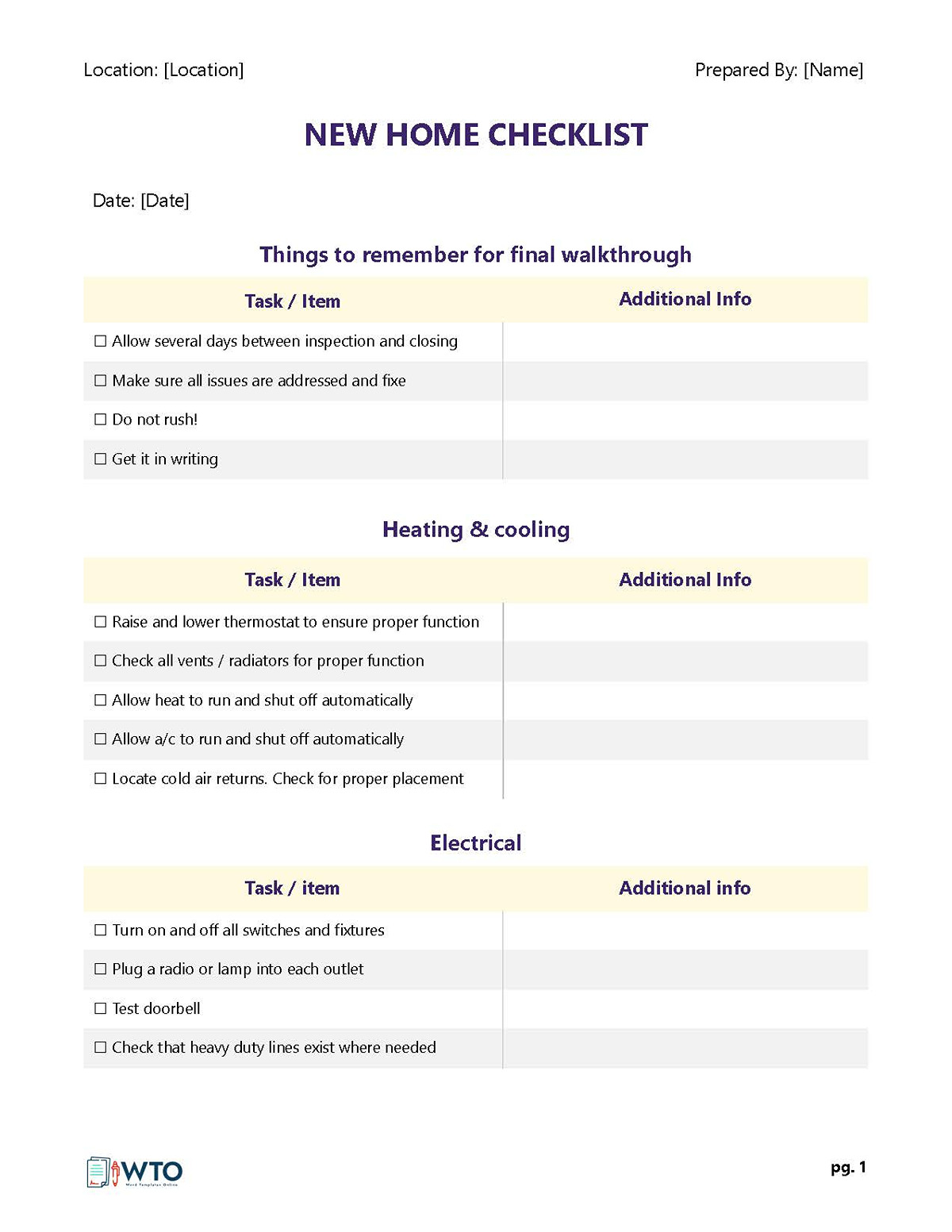
What Can be Excluded From a Home Inspection Checklist?
You may want to have as many areas as possible inspected. However, an inspector will typically not inspect everything within the property. Inspectors primarily focus on the physical components and systems of the house and not extras to the property.
Some of the items that may be excluded from a standard home inspection checklist are:
- Inside walls
- Landscaping
- Inside pipes or sewer lines
- Sprinkler systems
- Inside chimneys
- Internet service
- Behind electrical panels
- Septic tank systems
- Roofing covered in snow
- Toxic mold
- Chimney and fireplace
- Floor creaks and warps
- Pests
- Swimming pools
- Floor covered by carpet
- Asbestos
Frequently Asked Questions
You will typically have to pay for the home inspection as the buyer. However, this is subject to negotiation when making an offer. Some sellers will be willing to pay. Some even conduct a home inspection before listing the property to attract more buyers. However, it is always best to have your choice of inspector inspect the house for extra assurance.
The estimated average cost of a home inspection is $340. However, this price can vary from $280-$401 based on the size and location of the house. You should select an affordable and qualified inspector. This does not imply the cheapest. This cost may go up if additional examinations have to be undertaken.
A standard inspection can last 2-4 hours. However, this depends on the house size, the thoroughness of the inspector, amount of defects, and how well the home was prepared before the inspection.
Joining the inspector as they make their rounds in the home is advisable. This allows you to explore the house on-site, which can be more informative than reading a report. Often the inspectors will agree if you request to join.
A home inspection is conducted to search for defects and deficiencies. On the other hand, the appraisal is to assess a property’s value, which involves assessing the size, location, and general condition of the home without inspecting every minor part of the house. In addition, a home appraisal will typically be part of the financing or borrowing process. So, there are many instances where you may want to get both services done.

